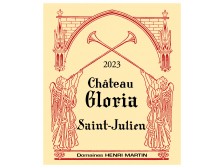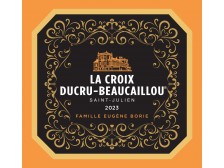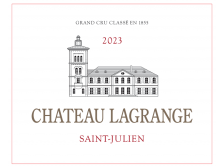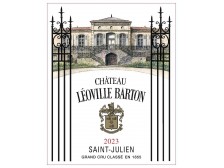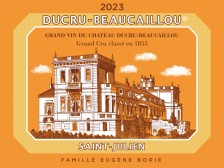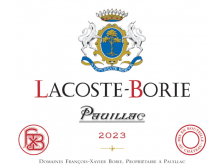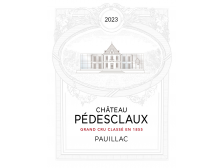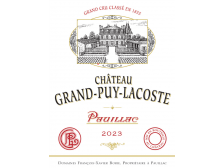2024 Futures
To find out about the week's releases, go to our Latest News page.
- More
- To keep or to drink:
- Available early 2026
- Potential alcohol:
- 13,16%
- Blend:
- 56 % Merlot, 41 % Cabernet Sauvignon, 3 % Petit Verdot
-
Second wine of Gruaud-Larose. In a rather powerful and tight register, Sarget is a serious and convincing Saint-Julien, with substance, at its best after 5 to 7 years of ageing.
More- To keep or to drink:
- Available early 2026
- Potential alcohol:
- 12.5%
- Blend:
- 52% Cabernet sauvignon, 40.5% Merlot, 4% Cabernet franc 4%, 3.5% Petit verdot
- Organic certification:
- 2022
-
Named Château Lalande-Borie until 2017, Le Petit Ducru is made from plots of great classified growths. A fine and distinguished Saint-Julien, in the spirit of Ducru-Beaucaillou.
More- To keep or to drink:
- Available early 2026
- Blend:
- 72% Merlot, 24% Cabernet Sauvignon, 4% Petit Verdot
-
The best cru bourgeois of Saint-Julien (it could easily have been classified in 1855), kept by the Saint-Pierre team, even owner, and in very good shape in the last vintages. The Médoc's best value par excellence.
More- To keep or to drink:
- Available early 2026
- Potential alcohol:
- 13.3%
- Blend:
- 50% Cabernet sauvignon, 35% Merlot, 10% Petit verdot, 5% Cabernet franc
- Organic certification:
- 2024
-
In the shadow of its older brother (Léoville-Barton), Langoa-Barton with a vineyard of barely 17 ha is the smallest and least known of the classified growths of Saint-Julien. Nevertheless, it offers the elegant and graceful fruitiness of Saint-Julien with a remarkable capacity for ageing. And a very reasonable price!
More- To keep or to drink:
- Available early 2026
- Potential alcohol:
- 13%
- Blend:
- 60 % Cabernet sauvignon, 37 % Merlot, 3 % Cabernet franc
-
Second wine of Ducru-Beaucaillou. As for the other wines made by Bruno Borie (Le Petit Ducru and Ducru-Beaucaillou), La Croix Ducru-Beaucaillou has considerably progressed since 2003 to the point of becoming a direct rival of the 3rd/4th classified growths of St-Julien. Moreover, it now benefits from a contribution of vines purchased from Château Terrey-Gros-Cailloux.
More- To keep or to drink:
- Available early 2026
- Blend:
- 58% Merlot Noir, 40% Cabernet Sauvignon, 15% Petit Verdot
-
The most serious and regular of the great classified growths of Saint-Julien, and even of the Médoc. Whatever the vintage since 1986, Lagrange never disappoints, with a constancy and an accuracy that force respect!
More- To keep or to drink:
- Available early 2026
- Organic certification:
- 84% Cabernet sauvignon, 16% Merlot
-
Since its purchase by Mr. Maroteaux, Branaire-Ducru has made rapid progress, as did the construction of the new winery, which allows it to work only by gravity, without a pump that could "chew" the wines. Branaire-Ducru is the leader of the appellation's 3-4ème crus classés (Lagrange, Talbot, Beychevelle, Saint-Pierre) and certainly the finest of them.
More- To keep or to drink:
- Available early 2026
- Potential alcohol:
- 13.1%
- Blend:
- 61% Cabernet sauvignon, 30% Merlot, 5,5% Cabernet franc, 3,5% Petit verdot
-
Saint-Pierre's obvious progress since 2003 now places it as a great rival to its peers in Saint-Julien, even surpassing them in depth of flesh. Magnificent in recent vintages, such as the 2019 rated 95/100 by the Revue des Vins de France "Great success" or the 2020 rated 96/100 "one of the most accomplished and refined ever".
More- To keep or to drink:
- Available early 2026
- Potential alcohol:
- 13.1%
- Blend:
- 80% Cabernet sauvignon, 17% Merlot, 3% Petit verdot
- Organic certification:
- 2024
-
Always black with ink, always deliciously fat and sweet, always St-Julien and above all always regular. Supervised by Mr. Derenoncourt since 2009, Talbot has gained in intensity and aromatic precision.
More- To keep or to drink:
- Available early 2026
- Potential alcohol:
- 13%
- Blend:
- 77 % Cabernet Sauvignon, 20 % Merlot, 3 % Petit Verdot
-
Clos du Marquis is no longer the second wine of Léoville-Las Cases, but a wine in its own right produced on the parcels adjoining Léoville-Poyferré and Lagrange. In any case, his exemplary consistency for more than 30 years now commands respect.
More- To keep or to drink:
- Available early 2026
- Potential alcohol:
- 13.5%
- Blend:
- 56% Cabernet Sauvignon, 35% Merlot, 9% Cabernet Franc
-
Even if their evolution always involves a period of austerity, Léoville-Barton wines have a supreme class and elegance, due as much to the advanced age of the vines as to meticulous work. Always praised by the critics, as in 2015 "fine, sapid and very long, lots of class on the palate, with a juicy side and superb texture", rated 97/100 by the Revue du Vin de France.
More- To keep or to drink:
- Available early 2026
- Potential alcohol:
- 13%
- Blend:
- 87% Cabernet sauvignon, 10% Merlot, 3% Cabernet franc
-
With the help of Michel Rolland, Léoville-Poyferré has gained in depth since 1993, voluptuousness of texture and ability to age. It is now approaching the quality of its prestigious neighbours in which it is landlocked: Léoville-Las Cases and Pichon-Lalande. The competition between the three Léoville is intense but Léoville-Poyferré now prevails with an easier, more voluptuous approach, and a superior quality/price/pleasure ratio.
More- To keep or to drink:
- Available early 2026
- Blend:
- 62% Cabernet Sauvignon, 32% Merlot, 4% Cabernet Franc, 2% Petit Verdot
-
Emblematic cru of the Médoc by its architecture as well as by the delicacy of its wines, internationally sought-after. Beychevelle has taken another step up in finesse and aromatic precision with the commissioning in 2018 of its new vat room, and is now on first-name terms with the commune's second growths.
More- To keep or to drink:
- Available early 2026
- Potential alcohol:
- 13.33%
- Blend:
- 61% Cabernet sauvignon, 35% Merlot, 4% Petit verdot
-
Of all the second classified growths in St-Julien, Gruaud-Larose is the most vigorous and massive in young wine. But, the magic of the terroir, it acquires softness and finesse if it is given time to age. Its quality/price ratio puts it ahead of the other second classified growths of St-Julien!
More- To keep or to drink:
- Available early 2026
- Potential alcohol:
- 12.5%
- Blend:
- 83% Cabernet sauvignon, 14.5% Merlot, 2.5% Cabernet franc
- Organic certification:
- 2022
-
Since the arrival of Bruno Borie in 2003, Ducru-Beaucaillou has been flying from success to success. No one has forgotten that, until 1980, Ducru was the greatest of the Médoc's second growths, a position it is now regaining. Bravo !
More- To keep or to drink:
- Available early 2026
- Blend:
- 85% Cabernet Sauvignon, 15% Merlot Noir
-
Intended for very long ageing in the cellar (at least 10 years even in small vintages), the wines of Léoville-Las Cases represent in each vintage one of the most perfect and purest expressions of the Médoc vineyard. As Wine Advocate has written, "Léoville-Las Cases looks more and more like Lafite rather than its close neighbour Latour".
Every vintage, Léoville-Las Cases is one of the contenders for the title of "best Bordeaux of the year", as once again with its 2020, rated 98+/100 by M. Galloni "Las Cases is one of the wines of the 2020 vintage, there is no doubt about that" and 99-100/100 by the Revue du Vin de France "a superlative wine for its depth, richness, but above all its definition".
More- To keep or to drink:
- Available early 2026
- Potential alcohol:
- 13.10%
- Blend:
- 86% Cabernet sauvignon, 10% Cabernet franc, 4% Merlot
-
Second wine of Grand-Puy Lacoste. Fruity, tender, silky, and always elegant. A classic at a reasonable price.
Variation case
In music, a variation is an evolution based on a defined theme. Grand-Puy-Lacoste has thus chosen to combine 3 different formats in a single case, enabling the evolution of the wine to be followed over time. The "Caisse Variation" thus contains 1 Double-Magnum, 2 Magnums and 4 Bottles, equivalent in volume to 12 bottles.More- To keep or to drink:
- Available early 2026
- Blend:
- 56% Cabernet sauvignon, 33% Merlot, 11% Cabernet franc
-
Ideally located on the Mouton plateau, next to prestigious crus classés such as d'Armailhac, Clerc-Milon and Pontet-Canet, Pibran is owned by the insurance company AXA and benefits from the expertise of the technical team of Pichon-Baron (same owner). There are only a few unclassified wines left in Pauillac, and Pibran is by far the best of them!
More- To keep or to drink:
- Available early 2026
- Potential alcohol:
- 13.1%
- Blend:
- 54% Cabernet Sauvignon, 46% Merlot
-
Since 2009 and the acquisition by Mr. Lorenzetti, we can talk about a new vintage wine classified in Pauillac. Unworthy of his ranking, Pédesclaux had until then disappeared from the Bordeaux scene. The ambition and resources of the new owner are there: complete overhaul of the installations, acquisition of new plots of land ideally located. The first vintages offer the image of a supple and easily accessible Pauillac, at a price that defies all competition in the appellation.
More- To keep or to drink:
- Available early 2026
- Potential alcohol:
- 13.3%
- Blend:
- 70% Cabernet sauvignon, 20% Merlot, 10% Cabernet franc
- Organic certification:
- 2022
-
Since 2010, Claire Villars (also at Ferrière and La Gurgue), puts back in the saddle Haut-Bages Liberal. With a qualitative terroir (adjacent to Latour), this certified organic wine since 2019 has become, for a reasonable price, the good deal of Pauillac.
More- To keep or to drink:
- Available early 2026
- Potential alcohol:
- 13.5%
- Blend:
- 86% Cabernet sauvignon, 14% Merlot
- Organic certification:
- 2019
-
New denomination of the second wine of Pichon-Baron from the 2012 vintage, undoubtedly at the level of the 5th growths of Pauillac.
More- To keep or to drink:
- Available early 2026
- Potential alcohol:
- 13.2%
- Blend:
- 57% Cabernet Sauvignon, 41% Merlot, 2% Petit Verdot
-
The arrival of Mr. Dhalluin in 2004 not only benefited Mouton-Rothschild, but also the two other classified growths of Barony: d'Armailhac and Clerc-Milon. Their vines occupy the southern (d'Armailhac) and northern (Clerc-Milon) part of the Mouton gravel plateau. D'Armailhac is barely less rich than Clerc-Milon, but it gives the same aromatic nobility of blackcurrant, tobacco and cedar blends.
More- To keep or to drink:
- Available early 2026
- Potential alcohol:
- 13.5%
- Blend:
- 70% Cabernet Sauvignon, 15% Merlot, 13% Cabernet Franc, 2% Petit Verdot
-
Second wine of Pichon-Comtesse de Lalande: velvety, generous, with well-polished tannins and aromas of ripe fruit with a very Pauillaise cedar note. A reliable and regular value, quickly developed.
More- To keep or to drink:
- Available early 2026
- Potential alcohol:
- 13%
- Blend:
- 60% Cabernet sauvignon, 30% Merlot, 5% Petit verdot, 5% Cabernet franc
- Organic certification:
- 2024
-
Grand-Puy-Lacoste is the finest of Pauillac's 5th classified growths, held with competence and care by Mr. François-Xavier Borie and his children. The latest vintages show even greater aromatic precision and tannin nobility, especially the superb 2020 vintage.
Variation Case
In music, a variation is an evolution based on a defined theme. Grand-Puy-Lacoste has thus chosen to combine 3 different formats in a single case, enabling the evolution of the wine to be followed over time. The "Caisse Variation" thus contains 1 Double-Magnum, 2 Magnums and 4 Bottles, equivalent in volume to 12 bottles.More- To keep or to drink:
- Available early 2026
- Blend:
- 77% Cabernet sauvignon , 23% Merlot
-
Property Rothschild (Mouton), with d'Armailhac. Apart from the terroir, the main difference between the two crus is the increased proportion of Merlot in Clerc-Milon (35% as opposed to 20%), giving it additional smoothness and richness. Since 2007 Clerc-Milon has benefited from its own vat room, a new winery and a dedicated team of 21 people so that Clerc-Milon can compete qualitatively with Lynch-Bages and Pontet-Canet.
More- To keep or to drink:
- Available early 2026
- Potential alcohol:
- 13.5%
- Blend:
- 72% Cabernet Sauvignon, 19% Merlot, 6.5% Cabernet Franc, 1.5% Carmenère, 1% Petit Verdot
-
Known for producing one of the firmest and tightest (even robust) Pauillacs available, Duhart-Milon has since 2010 refined its style to gradually approach that of Lafite (same owner and same team). New direction and progress amply confirmed, with an unprecedented charm and fatness from the 2015 vintage onwards. Given the quality of its terroir (the only 4th Grand Cru Classé in Pauillac), Duhart-Milon has certainly not finished its progression.
As the latest Bettane & Desseauve guide (2025) points out, “So many changes in recent vintages, with a great wine that has rediscovered the depth and dimension of the greatest Pauillacs”!
More- To keep or to drink:
- Available early 2026
- Organic certification:
- 2024
-
Contiguous to Mouton-Rothschild, Pontet-Canet is in good vintages the very type of great Pauillac, straight and racy. The first of the Grands Crus Classés to be certified "organic" (in 2010), Pontet-Canet has been at the top of the Médoc since 2000.
More- To keep or to drink:
- Available early 2026
- Potential alcohol:
- 13.5%
- Blend:
- 52% Cabernet sauvignon, 39% Merlot, 6% Cabernet franc, 3% Petit verdot
- Organic certification:
- 2010
-
Apart from the first great classified growths, no other Bordeaux wine is as world famous as Lynch-Bages. Its worldwide success comes as much from its opulent, full-bodied and robust style, from its unfailing regularity since 1975, and from its media promotion orchestrated by Jean-Michel Cazes. Lynch-Bages was the first wine sent into space (Discovery shuttle in 1985). It is even said that it is him who gave the taste of Bordeaux to the Americans!
More- To keep or to drink:
- Available early 2026
- Potential alcohol:
- 13.7%
- Blend:
- 71 % Cabernet sauvignon, 24 % Merlot, 3 % Cabernet franc, 2 % Petit verdot
-
Bought in 1986 by the AXA group, initially under the leadership of Mr. Cazes (Lynch-Bages), Pichon-Longueville Baron regained its best form in the powerful and distinguished style of the great Pauillac. It must be said that a small half of its vines are located next to those of Latour, on a first growth terroir! For the Revue du Vin de France: "Pichon-Baron is at the top in the last vintages".
More- To keep or to drink:
- Available early 2026
- Potential alcohol:
- 13.2%
- Blend:
- 80 % Cabernet Sauvignon, 20 % Merlot






